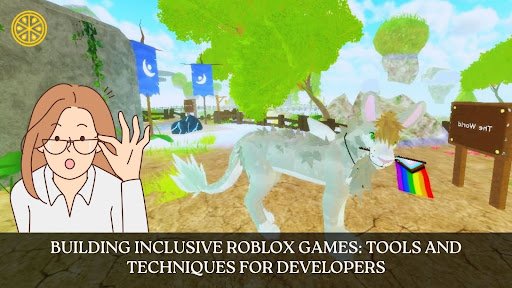Why Does Inclusivity Matter in Roblox Games?
As a Roblox game developer, you might have wondered: “Am I doing enough to make my game welcoming for everyone?” It’s a fair concern, especially when creating a game intended for a global audience with diverse players. Many developers overlook aspects like accessibility or cultural sensitivity, which can inadvertently alienate certain players.
But with thoughtful design and the right tools, you can make your games enjoyable for everyone, regardless of their background, abilities, or preferences.
Inclusivity isn’t just a moral obligation; it’s also a smart design choice. When your game caters to a wider audience, you’re expanding its reach and boosting its potential for success.
Moreover, creating an inclusive environment fosters a sense of community and belonging among players, making them more likely to stick around and recommend your game to others. This translates to better engagement and retention rates, which are crucial for any successful Roblox game.
What Are the Key Elements of Inclusive Game Design?
1. Accessibility: Making Games Usable for All
Accessibility is one of the most important pillars of inclusivity. It ensures that players with disabilities can fully experience and enjoy your game. Here are some practical steps you can take:
- Visual Accessibility: Include colorblind-friendly palettes and customizable text sizes. Use high-contrast UI elements for better visibility.
- Audio Accessibility: Provide subtitles for in-game dialogues and sound cues. Use visual indicators for critical actions that rely on sound.
- Motor Accessibility: Offer customizable controls and alternative input methods like voice commands or one-button controls.
For instance, if your game involves solving puzzles, consider adding an “assist mode” that simplifies complex actions. This can help players with cognitive or motor impairments enjoy the gameplay without frustration.
2. Cultural Sensitivity: Respecting Diverse Backgrounds
Roblox games attract players from all over the world. To make everyone feel included, pay attention to cultural nuances:
- Avoid stereotypes and ensure your characters represent a variety of cultures authentically.
- Use language that’s neutral and universally understood.
- Incorporate inclusive storylines that celebrate diversity rather than perpetuating bias.
A great example is avoiding holiday-specific themes that may not resonate globally. Instead of centering your game around Christmas, you could use a generic winter theme to appeal to players from different cultures.
3. Gender Inclusivity: Breaking Stereotypes
Games have historically leaned into gender stereotypes, often alienating non-binary players or those who don’t conform to traditional gender roles. Here’s how you can address this:
- Allow players to customize their avatars freely, without limiting choices based on gender.
- Use gender-neutral language in dialogues and instructions.
- Avoid perpetuating stereotypes in character roles or narratives.
When you let players express themselves freely, you’re creating a space where they feel seen and respected, which can make your game more engaging.
Tools to Help You Build Inclusive Roblox Games
1. Accessibility Features in Roblox Studio
Roblox Studio offers several built-in tools to help developers enhance accessibility:
- Text-to-Speech Plugins: Enable audio feedback for players who rely on auditory cues.
- Color Adjustment Settings: Test your game in different colorblind modes to ensure visibility for all players.
- Custom Scripts for Accessibility: Write scripts that allow players to adjust difficulty levels or control sensitivity.
2. Community Resources and Frameworks
Leverage the Roblox developer community to find resources and frameworks tailored for inclusivity:
- Roblox Developer Hub: Offers tutorials on implementing accessibility and inclusivity features.
- Inclusive Game Design Frameworks: Use guides like “AbleGamers Player Panels” to understand the needs of diverse players.
- Open-Source Plugins: Look for free plugins created by other developers to add accessibility features to your game.
3. Feedback and Playtesting
Inclusivity is an ongoing process. The best way to ensure your game is inclusive is by collecting feedback:
- Conduct playtests with diverse groups of players.
- Use surveys to ask players about their experience.
- Continuously update your game based on feedback to address gaps in inclusivity.
How to Implement Inclusivity in Game Design?
Step 1: Start with a Plan
Inclusivity starts at the planning stage. Before you even begin developing, outline your goals:
- Who is your target audience?
- What barriers might these players face?
- How can you address these barriers in your game design?
Step 2: Use Inclusive Design Principles
Apply the following principles throughout the development process:
- Flexibility: Allow players to customize their experience.
- Simplicity: Make your game mechanics easy to understand and use.
- Equity: Ensure all players have equal opportunities to succeed.
Step 3: Test, Iterate, Repeat
Inclusivity isn’t a one-time effort. Regular testing and updates are essential:
- Use accessibility testing tools to identify potential issues.
- Gather feedback from diverse player groups.
- Continuously refine your game based on real-world usage.
Common Challenges and How to Overcome Them
Challenge 1: Lack of Awareness
Many developers simply aren’t aware of the barriers players face. Education is key. Take the time to learn about accessibility standards and best practices.
Challenge 2: Resource Constraints
Adding inclusive features can seem time-consuming or expensive. Start small by implementing high-impact changes like subtitles or customizable controls. Gradually expand your efforts as you gain experience.
Challenge 3: Resistance to Change
Some developers worry that inclusivity features might complicate their game or alienate their existing audience. In reality, inclusive games often attract more players and create a stronger community.
Real-Life Example: A Success Story in Inclusive Game Design
Consider a Roblox developer who created a multiplayer adventure game. Initially, the game was visually stunning but inaccessible to players with colorblindness. After introducing colorblind modes and customizable text sizes, the game saw a 20% increase in player retention. This demonstrates how small changes can make a big difference.
Conclusion
Building inclusive Roblox games isn’t just about following trends—it’s about creating experiences that everyone can enjoy. By focusing on accessibility, cultural sensitivity, and gender inclusivity, you can design games that welcome players from all walks of life. Use the tools available in Roblox Studio, seek feedback from diverse players, and continuously refine your approach.
Remember, inclusivity benefits both your players and your game’s success. Let’s work together to make Roblox a platform where everyone feels at home.











